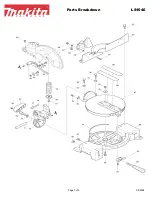
•
Store idle tools out of reach of children and other untrained
persons. Tools are dangerous in the hands of untrained users.
•
When battery pack is not in use, keep it away from metal
objects like: paper clips, coins, keys, nails, screws, or other
small metal objects that can make a connection from one
terminal to another. Shorting the battery terminals together may
cause sparks, burns, or a fire.
•
Maintain tools with care. Keep cutting tools sharp and clean.
Properly maintained tools, with sharp cutting edges are less likely
to bind and are easier to control.
•
Check for misalignment or binding of moving parts, breakage
of parts, and any other condition that may affect the tools
operation. If damaged, have the tool serviced before using.
Many accidents are caused by poorly maintained tools.
•
Use only accessories that are recommended by the
manufacturer for your model. Accessories that may be suitable
for one tool may create a risk of injury when used on another tool.
SERVICE
•
Tool service must be performed only by qualified repair
personnel. Service or maintenance performed by unqualified
personnel may result in a risk of injury.
•
When servicing a tool, use only identical replacement parts.
Follow instructions in the Maintenance section of this manual.
Use of unauthorized parts or failure to follow Maintenance
Instructions may create a risk of shock or injury.
Additional Specific Safety Instructions
•
Hold tool by insulated gripping surfaces when performing an
operation where the cutting tool may contact hidden wiring.
Contact with a “live” wire will also make exposed metal parts of
the tool “live” and shock the operator.
CAUTION: Some tools with large battery packs will stand upright
on the battery pack but may be easily knocked over. When not in use,
place tool on its side on a stable surface where it will not cause a
tripping or falling hazard.
1
English
WARNING: Some dust created by power sanding, sawing, grinding,
drilling, and other construction activities contains chemicals known to
cause cancer, birth defects or other reproductive harm. Some
examples of these chemicals are:
• lead from lead-based paints,
• crystalline silica from bricks and cement and other masonry
products, and
• arsenic and chromium from chemically-treated lumber (CCA).
Your risk from these exposures varies, depending on how often you do
this type of work. To reduce your exposure to these chemicals: work in
a well ventilated area, and work with approved safety equipment, such
as those dust masks that are specially designed to filter out
microscopic particles.
•
Avoid prolonged contact with dust from power sanding,
sawing, grinding, drilling, and other construction activities.
Wear protective clothing and wash exposed areas with soap
and water. Allowing dust to get into your mouth, eyes, or lay on the
skin may promote absorption of harmful chemicals.
CAUTION: Wear appropriate personal hearing protection during
use. Under some conditions and duration of use, noise from this
product may contribute to hearing loss.
•
The label on your tool may include the following symbols.
V ..............volts
A ................amperes
Hz ............hertz
W ..............watts
min ..........minutes
............alternating current
..........direct current
no ..............no load speed
............Class II
..............earthing terminal
................
Construction
..............safety alert symbo
.../min ......revolutions per minute
Important Safety Instructions for Battery
Chargers
•
This manual contains important safety and operating instructions.





































